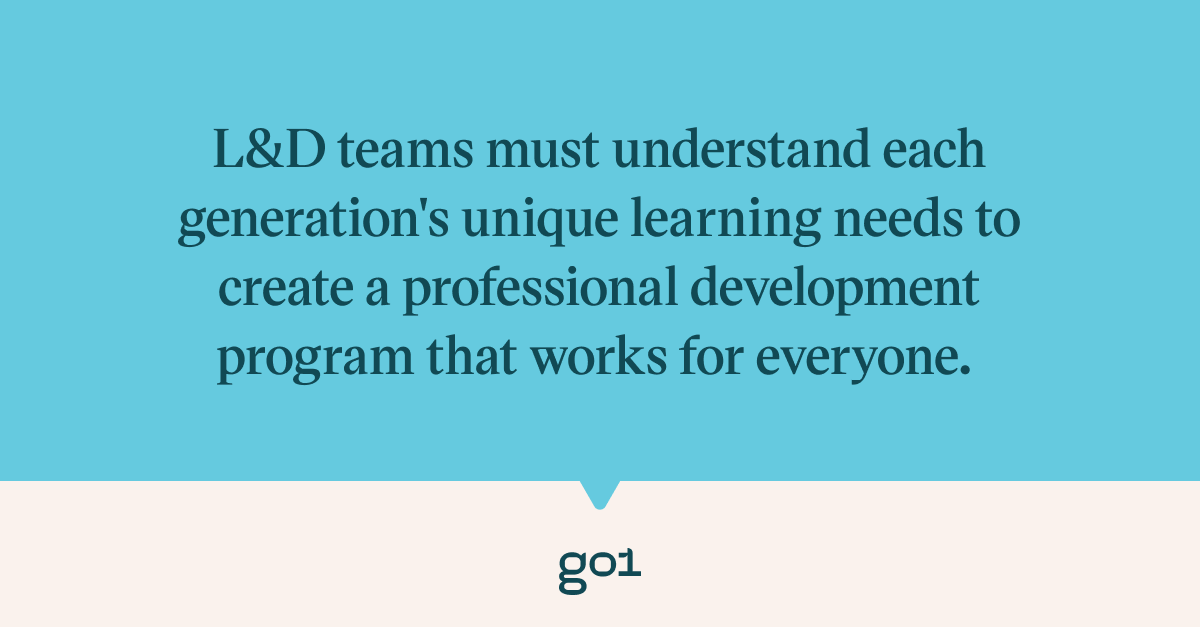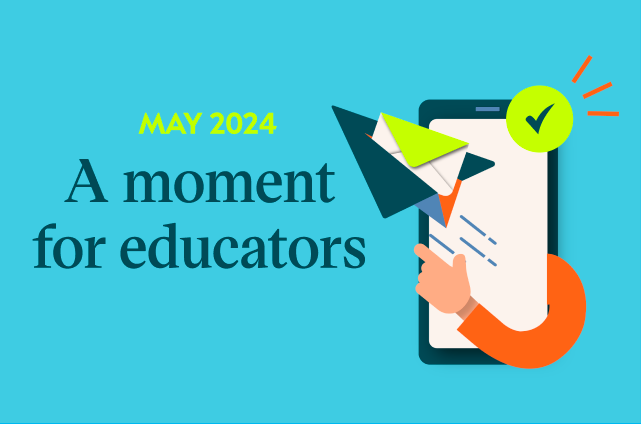
Learning strategies for a multigenerational workforce

We're living through a unique era of work where employees span four generations: Baby Boomers, Gen X, Millennials, and Gen Z. As workplaces become increasingly diverse, a one-size-fits-all approach to learning is no longer engaging or effective. Instead, learning and development teams must understand each generation's unique learning needs to create a professional development program that works for everyone.

In this article, we'll outline the differences in each generation's learning styles and provide practical strategies you can use to foster an inclusive environment. By understanding each generation represented in your workforce, your organization can craft training initiatives that empower all employees, regardless of age or experience.
Baby Boomers: The traditional learners
Born between 1946 and 1964, Baby Boomers continue to play a significant role in the workforce. In fact, 19% of Americans ages 65 and older were working in 2023—that’s almost double the number of older adults who were employed 35 years ago.
With their wealth of experience and strong work ethic, this generation brings a valuable perspective to any organization. When it comes to learning and development, Baby Boomers have their own unique set of preferences. They highly value credentials, job titles, and work experience as a reflection of their expertise and achievements. To engage them effectively, it's important to provide opportunities for them to continue learning and share their knowledge with others.
While some Baby Boomers may not be as tech-savvy as younger generations, many are quite adept and open to new tools and methods. Consider the COVID-19 pandemic, when many baby boomers learned new technology skills to safely stay in touch with loved ones. Still, this generation often prefers in-person or instructor-led training sessions. These traditional methods provide them with the opportunity to interact directly with trainers and peers, ask questions, and receive immediate feedback.
To best support Baby Boomers in their learning journey, we've found that structured, well-organized training programs work best. This generation appreciates clear objectives, a logical progression of topics, and in-depth training sessions. Consider holding in-person workshops or webinars led by employees from your organization or expert guest speakers from outside your business. For Baby Boomers, it's all about creating an environment where they can learn directly from an instructor and immerse themselves in the details of a topic.
Gen X: The independent learners
With Gen X representing over a third of the workforce and more than 50% of management, this generation plays a significant role in today's workplace. Gen X are known for their independence and self-reliance. They favor self-directed and experiential learning, and they often take the lead in charting their learning journey.
To cultivate a training environment that resonates with Gen X, you need to offer them the freedom to learn autonomously while ensuring they get the attention they deserve. Gen X is much smaller in size than other generations, and they don’t hold the corporate power of Baby Boomers or the technological prowess of Millennials. Known as the “Forgotten Generation,” eight out of ten Gen X employees say they feel forgotten in the workplace, and according to our research, they're promoted at rates 20% to 30% slower than Millennials.
Understanding Gen X’s needs for both independence and recognition, it's crucial to provide regular feedback and acknowledgment, creating a culture where this generation can assess their growth and receive input from both leaders and colleagues. A learning program that works for Gen X will include mentorship and feedback, hands-on learning, and practical opportunities to apply skills. Consider getting managers involved to provide regular check-ins where they can track training progress and recognize learning achievements. Gen X will thrive through learning that's both flexible and supportive.
Millennials: The online learners
Millennials were the first generation to grow up with technology at their fingertips, and they're experts at using it in nearly every aspect of their lives. Our research has shown that 41% of millennials usually choose to communicate electronically instead of face-to-face. This generation is known for their curiosity and open-mindedness, and they thrive in environments where they can learn through hands-on, experiential learning approaches like simulations and virtual role-playing.
The internet has given Millennials a way of learning that looks significantly different from older generations in the workplace. While they may not be as drawn to traditional methods, they're eager to use online tools to their advantage. They prioritize meaningful work and seek out training to develop technology skills and interpersonal skills for leadership roles.
Millennials will make up 50% of the workforce by next year in 2025, and L&D plays a vital role in helping them become better positioned to adapt to the ever-changing business landscape and remain competitive in the face of ongoing disruption. Current leadership can help Millennials by offering a wide variety of learning opportunities, including online courses, on-the-job training, and collaborative learning to engage and help them connect with their peers.

Gen Z: The short-form learners
Gen Z has just recently entered the workforce, and they've brought their own unique learning styles and expectations with them. As newcomers, this generation is eager to learn, grow, and progress in their careers.
Gen Z are true digital natives who have a world of information at their fingertips and thrive on constantly staying connected. Unlike any other generation, they were born with smartphones in their hands (metaphorically, of course). Their entrepreneurial spirit and initiative makes them great at finding information on their own. They prefer visual learning and often use social media to learn. It makes sense, then, that they gravitate toward microlearning over more in-depth courses, and that they enjoy immersive, interactive content that's accessible on the go.
While Gen Z excels at technology, 37% say they feel worried that technology weakens their ability to develop people skills. This is likely why Gen Z prioritizes collaborative environments where they can bounce ideas off their peers and reinforce their understanding, like co-working spaces. A training program that offers both bite-sized learning content and opportunities to learn in groups will enable Gen Z to develop new skills successfully.
Creating an inclusive learning environment
No matter the generation, if you want to attract and retain talent, prioritize creating an inclusive learning program. By fostering an environment that values diversity, companies can harness the unique perspectives and experiences that each employee brings to the table. This means recognizing and celebrating everyone's differences and ensuring learning is available in accessible formats, styles, and topics for employees from every generation.
Creating an inclusive learning space also requires cultivating a supportive environment, free from judgment. You can help create this environment by offering training on topics like psychological safety, active listening, and diversity. It’s especially important to get managers on board with this training so they can lead by example and empower their multigenerational teams to take risks, embrace new challenges, and continuously develop their skills.
Finally, be sure to regularly ask employees for feedback. By keeping communication channels open and actively listening to what employees have to say about their learning needs and preferences, your organization can continually fine-tune your learning programs and ensure your learning initiatives work for everyone.

Want to learn more about how you can meet the upskilling and training needs of a multi-generational workforce? Check out our multi-generational learning report!
For more insights, subscribe to the Go1 newsletter to stay on top of all the latest L&D trends. Or, you can book a demo today to find out how Go1 can help with your team’s learning needs.



